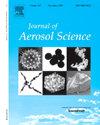Comparative analysis of Eulerian and Lagrangian models for the simulation of fine and ultrafine particle dynamics in the wake of a heavy truck
IF 2.9
3区 环境科学与生态学
Q2 ENGINEERING, CHEMICAL
引用次数: 0
Abstract
Predicting the turbulent dispersion of particulate pollutants is essential for understanding and mitigating the environmental impact of road traffic emissions, particularly those from heavy vehicles. This study examines the behavior of low-inertia particles in the turbulent wake of a heavy truck, a region dominated by complex and inhomogeneous airflow that significantly influences pollutant dynamics. Numerical simulations were performed based on the RANS-SST model for carrier-phase flow characterization, and three different approaches were applied to model the dispersed phase, namely the Lagrangian eddy interaction model (EIM), the Eulerian diffusion-inertia model (DIM) and a scalar advection–diffusion equation. To assess the accuracy of these numerical models, experimental measurements were carried out in an open-circuit wind tunnel. Particle image velocimetry (PIV) was used to characterize airflow, while a low-pressure electric impactor (ELPI) measured particle concentrations.
While numerical simulations generally aligned with experimental data, the Lagrangian EIM model overestimated particle concentrations at the wake vortex periphery, highlighting some limitations in capturing particle-turbulence interactions in highly anisotropic and inhomogeneous flows. Conversely, the Eulerian DIM and scalar advection–diffusion models proved closer to the experimental results, reasonably reproducing low-inertia particle dispersion, where inertial effects were found to be negligible. These results underline the importance of selecting an appropriate combination of turbulence and particle models to simulate the dispersion of particulate pollutants, providing valuable information for improving forecasts of traffic-related pollution and its environmental and health impacts.
重型卡车尾迹中细颗粒和超细颗粒动力学模拟的欧拉和拉格朗日模型的比较分析
预测颗粒污染物的湍流扩散对于理解和减轻道路交通排放,特别是重型车辆排放对环境的影响至关重要。本研究考察了低惯性颗粒在重型卡车湍流尾迹中的行为,这是一个由复杂和不均匀气流主导的区域,显著影响污染物动力学。基于ranss - sst kω模型进行了数值模拟,采用拉格朗日涡旋相互作用模型(EIM)、欧拉扩散-惯性模型(DIM)和标量平流-扩散方程三种不同的方法对流相进行了模拟。为了评估这些数值模型的准确性,在开路风洞中进行了实验测量。颗粒图像测速仪(PIV)用于表征气流,而低压电冲击器(ELPI)测量颗粒浓度。虽然数值模拟与实验数据基本一致,但拉格朗日EIM模型高估了尾流边缘的颗粒浓度,突出了在高度各向异性和非均匀流动中捕捉颗粒-湍流相互作用的一些局限性。相反,欧拉DIM和标量平流扩散模型证明更接近实验结果,合理地再现了低惯性粒子色散,其中惯性效应被发现可以忽略不计。这些结果强调了选择湍流和颗粒模型的适当组合来模拟颗粒污染物扩散的重要性,为改进与交通有关的污染及其环境和健康影响的预测提供了有价值的信息。
本文章由计算机程序翻译,如有差异,请以英文原文为准。
求助全文
约1分钟内获得全文
求助全文
来源期刊

Journal of Aerosol Science
环境科学-工程:化工
CiteScore
8.80
自引率
8.90%
发文量
127
审稿时长
35 days
期刊介绍:
Founded in 1970, the Journal of Aerosol Science considers itself the prime vehicle for the publication of original work as well as reviews related to fundamental and applied aerosol research, as well as aerosol instrumentation. Its content is directed at scientists working in engineering disciplines, as well as physics, chemistry, and environmental sciences.
The editors welcome submissions of papers describing recent experimental, numerical, and theoretical research related to the following topics:
1. Fundamental Aerosol Science.
2. Applied Aerosol Science.
3. Instrumentation & Measurement Methods.
 求助内容:
求助内容: 应助结果提醒方式:
应助结果提醒方式:


